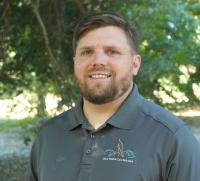
Facilities 101: Water pressure is important for oiled wildlife!
Back in late June/early July, the OWCN management team traveled down to the Marine Wildlife Veterinary Care and Research Center (MWVCRC) in Santa Cruz to participate in a sea otter wash drill with our partners at CDFW-OSPR. At this drill I found myself serving as the facilities lead as we were also drilling the facility. In this role it was my job to ensure continued function of equipment and facility infrastructure to include lighting, wash table functionality, water quality, water pressure, boiler functionality, etc. As you may know there are ideal water parameters for the washing/ rinsing of oiled wildlife and depending on the species these parameters vary. We typically look for water hardness of 2-5 grains per gallon, water temp at 104-106 degrees Fahrenheit for birds and 80-90 degrees for mammals, and a water pressure range of 40-60 PSI.

Due to the washroom at MWVCRC sitting mothballed (while maintaining a state of readiness for activation in an oiled wildlife response), the washroom is not often used for its intended purpose, which is to wash oiled otters. Instead, it is inspected frequently to ensure proper function of systems; however, there is nothing better than drilling and using the room for the intended purpose. During the drill at MWVCRC we identified a water pressure issue from our rinse nozzles at the wash tables. This was no fault to the state of the washroom but more to the needs of washing each individual otter. Without diving into the exact details of what the exact requirements are for washing and caring for sea otters in the wash rinse process, we identified that one wash nozzle per table would not be enough for the task.
Knowing this, I dove into troubleshooting one of the wash table's mixing valve set-ups. Each valve could run a single wash nozzle but when demanding it to run, another pressure would drop drastically (far below 40 PSI) to the point it severely affected the rinse process. It was quickly determined that the valve itself was the problem because it was not rated to run two wash nozzles simultaneously and maintain the pressure needed. This find would be further addressed in our after-action review, in which I was ultimately assigned to come up with a solution to our wash nozzle pressure problem.
After doing research on mixing valves, I identified one that would meet the specifications needed to run two rinse nozzles while keeping in mind the volume and pressure coming from the service lines to each table. The next step was providing a proof-of-concept by installing one new valve on a single wash table before tackling the replacement of the 5 valves at each of the wash tables at MWVCRC. Parts were then ordered and a follow-up trip to MWVCRC was planned.
Mid-August, I found myself headed back to MWVCRC to install the new valve on one of the wash tables. Luckily Sean Kam, the facilities and equipment manager for MWVCRC, was on-site and eager to assist. After a few unexpected hurdles, Sean and I were able to get the new valve installed along with two wash nozzles on a single wash table. We followed installation with a series of pressure tests and we couldn’t be more pleased with the results. The new valve could sustain a pressure above 50 PSI with two wash nozzles fully opened. The following table shows our comparison of new and old pressure test results.
MWVCRC Washroom Valve Specs (PSI) | |||
Wash Nozzles Open | 0 | 1 | 2 |
Old Valve (Hydroguard 420) | 56-60 | 41 | 16 |
New Valve (Leonard TM26LF) | 56-60 | 52 | 50-52 |

Now that we provided a proof-of-concept, we will move forward with installing these new valves on the remaining wash tables in coordination with the folks at MWVCRC. We look forward to future drills with these much-needed upgrades and will be ready if we need to activate the facility in the event of an oil spill.
Thanks for reading!
Danny Vickers
Wildlife Logistics Specialist, OWCN

